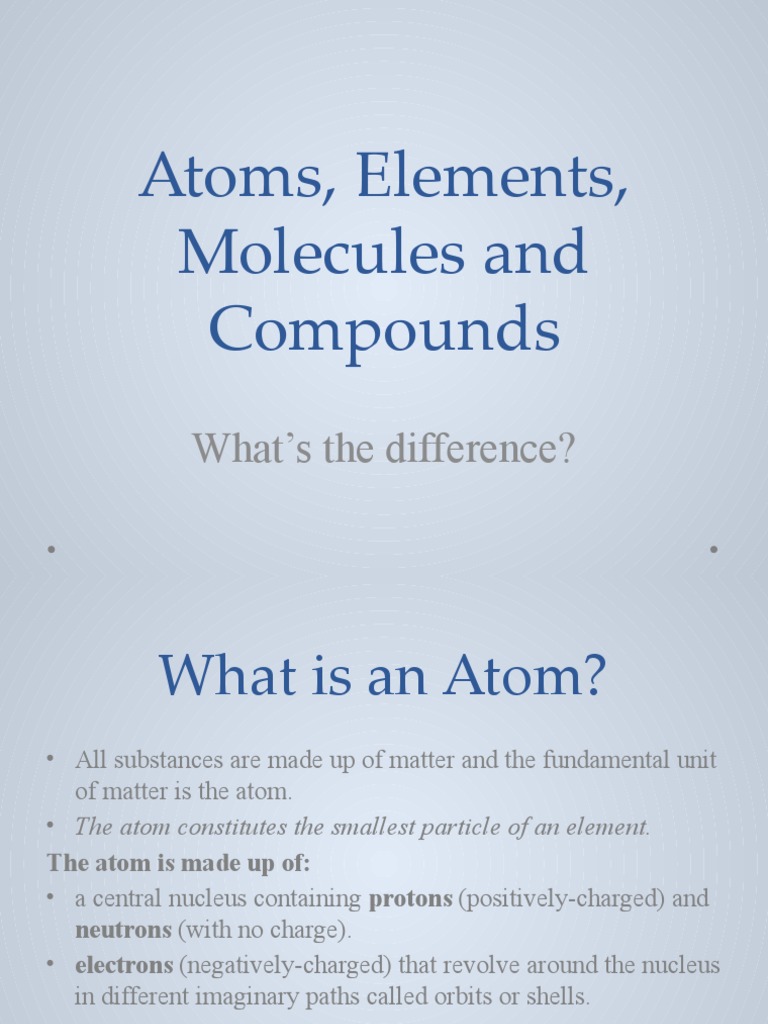In the realm of chemistry, a nuanced understanding of the fundamental constituents of matter is paramount. Two of the most foundational categories of this matter are elements and molecules. While often conflated in casual discourse, these two concepts signify markedly different entities within the scientific framework. A thorough exploration of their distinctions is critical for any in-depth study of chemical science.
1. Defining Elements and Molecules
At the most rudimentary level, an element is defined as a substance that cannot be decomposed into simpler substances by chemical means. Elements serve as the fundamental building blocks of matter, each characterized by a unique number of protons within their atomic nucleus. The Periodic Table of Elements categorizes these constituents, which include well-known examples such as hydrogen (H), carbon (C), and oxygen (O).
In contrast, a molecule is a distinct entity formed when two or more atoms bond together through covalent bonds. These atoms may be of the same element or different elements. Molecules serve as the smallest identifiable units of a chemical compound that retain the chemical properties of that compound. For example, the molecule H2 consists of two hydrogen atoms, while the molecule H2O features two hydrogen atoms covalently bonded to one oxygen atom.
2. Composition: Variability in Atoms
One of the most salient distinctions between elements and molecules lies in their atomic composition. Elements are solely composed of identical atoms – a characteristic that makes them unyielding to decomposition under standard chemical conditions. This homogeneity is exemplified by neon (Ne), a noble gas element that exists as discrete, monatomic entities.
Molecules, however, exhibit greater variability. They can be homonuclear, comprising atoms of the same element, as seen in nitrogen gas (N2), or heteronuclear, comprising various elements, as is the case with carbon dioxide (CO2). This diversity in molecular composition is fundamental when discussing chemical reactions and bonding behavior, as the interactions between different types of atoms fundamentally alter molecular characteristics.
3. Physical Properties and States of Matter
The physical properties of elements and molecules often differ substantially, which can be attributed to their underlying atomic structure. Elements, particularly metals, exhibit a range of physical properties, including conductivity, malleability, and metallic luster. Nonmetals, on the other hand, often display properties in stark contrast to their metallic counterparts, tending to be brittle or gaseous at room temperature.
Molecules can exist in various states of matter, depending on temperature and pressure conditions. For instance, water (H2O) can exist as a solid (ice), liquid (water), or gas (steam), demonstrating the versatility of molecular structures. In contrast, elements like iron exhibit primarily solid-state properties under standard conditions, with their molecular behavior dictated by their atomic structure and bonding character.
4. Chemical Behavior and Reactivity
Another fundamental distinction lies in the reactivity of elements versus molecules. Elements display unique chemical behaviors based on their position on the Periodic Table. For example, alkali metals (like sodium and potassium) are characterized by their high reactivity, especially with water, due to their tendency to lose a single electron. Conversely, noble gases are largely inert, displaying minimal reactivity because their outer electron shells are complete.
Molecules, umbilically linked to the atoms they comprise, inherently reflect the properties of these constituent elements. Furthermore, molecular reactivity depends on the arrangement of atoms, bond strengths, and types of functional groups present. A classic illustration can be found in hydrocarbons, where the molecular structure determines their reactivity with halogens or oxygen during combustion reactions.
5. Compounds versus Elements: The Composite Nature of Molecules
The distinction between elements and molecules leads to yet another layer of complexity: that of compounds. While elements represent pure substances, molecules can exist as compounds – substances formed from two or more different elements. For example, sodium chloride (NaCl) is a compound composed of sodium (an element) and chlorine (another element). This distinction emphasizes the molecular capacity to interact and bond, leading to the formation of new and diverse substances.
6. Practical Implications in Chemistry
A professional understanding of the difference between elements and molecules is pivotal, not only for academic inquiries but also for practical applications in fields such as pharmacology, materials science, and environmental chemistry. The molecular composition of compounds affects how they interact biologically or chemically within different environments, which is crucial in drug formulation and environmental remediation strategies.
In summary, the differentiation between molecules and elements serves as a cornerstone of chemical education and practice. While elements are the purest form of matter that cannot be broken down, molecules reflect a more complex structure that can result from the combination of different elements. The interplay of these two foundational aspects of chemistry informs our understanding of the universe, enabling advancements in technology, medicine, and environmental science.












